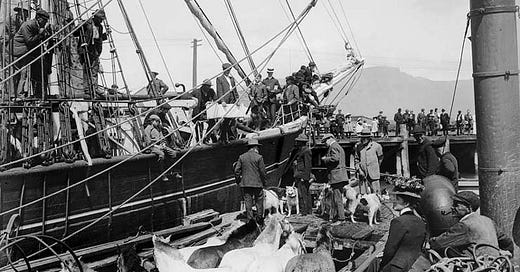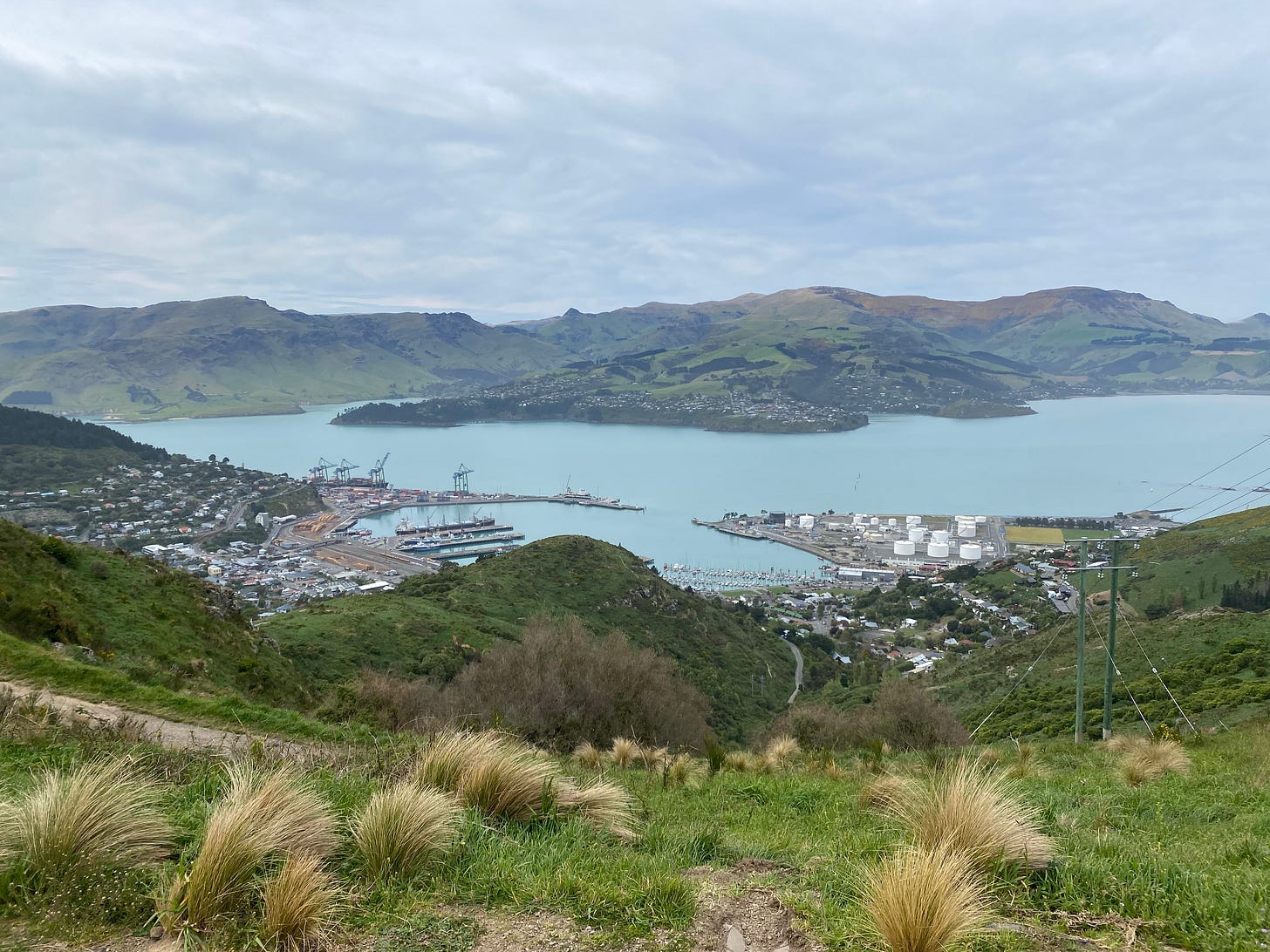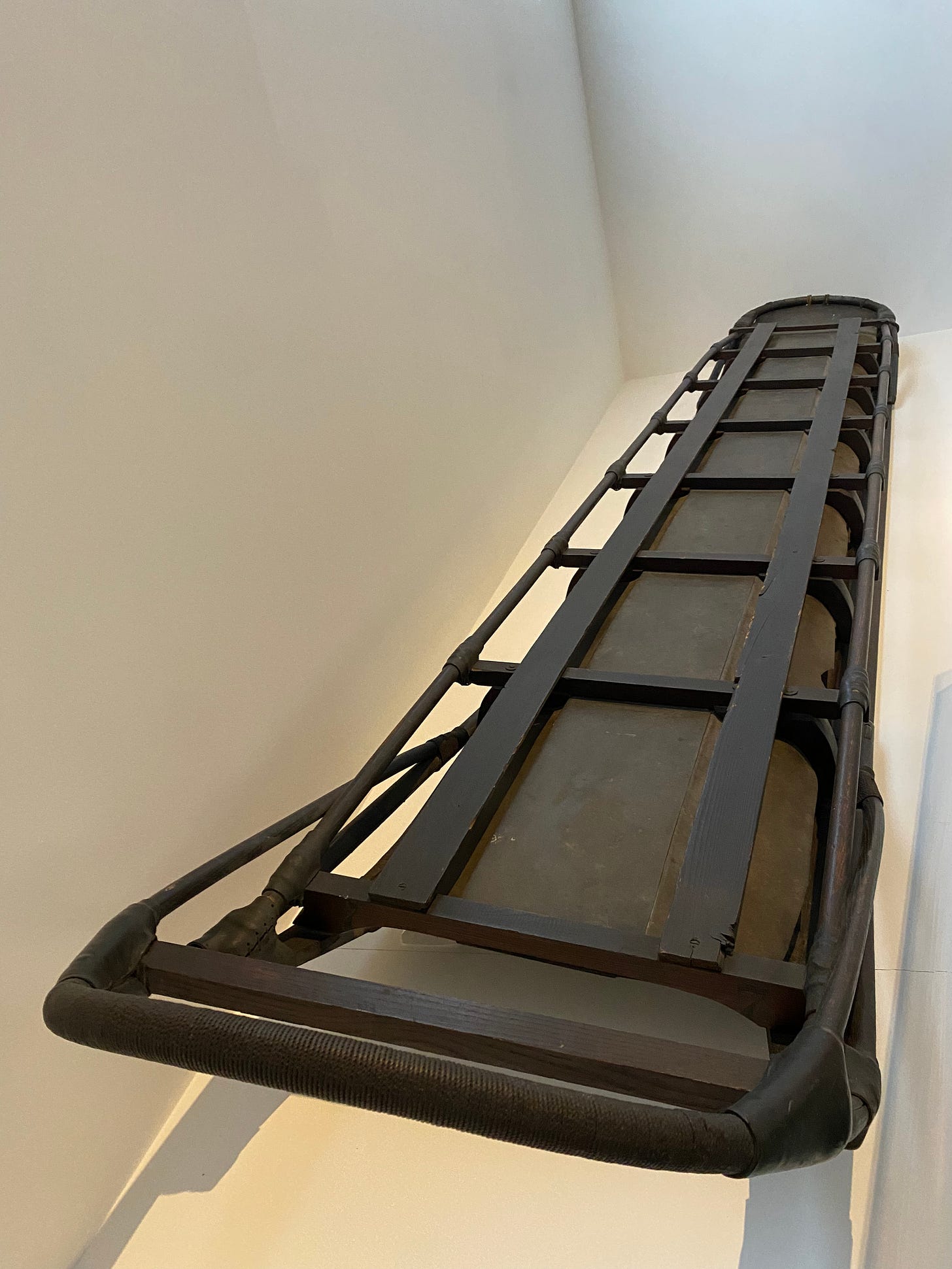Stuck in Christchurch, NZ, hoping to catch that C-17 to Antarctica soon
Plus Lyttelton, NZ's role in the history of ocean-going Antarctic expeditions
Shackleton Expedtion loading at Lyttelton Harbor, 1914. Photo credit James McDonald. The Museum of New Zealand Ta Papa Tongarewa.
My fellow “deployers” aren’t difficult to spot amidst the crowd at Auckland Airport. The engorged North Face and L.L.Bean duffels stacked on luggage trolleys are a sure tell but it’s the scrappy, hiker vibe that ultimately distinguishes them. In stance and expression they remind me of college freshmen during orientation—nervous humans trying too to look devil-may-care-cool even as the eagerness to enter the group, to be known and accepted, seeps out from between the seams of their Patagonia fleece. I don’t doubt I’m describing my demeanor as much as theirs—I’m itchy to meet others who will be going south with me but I’ll be damned if I’ll risk appearing needy.
Spotting those first pole specimens in Auckland gives me a silly thrill. I approach them, cautious but friendly, “You guys happen to be headed to McMurdo?” We chat briefly. After covering the predictable details of flight delays and middle seats (I lucked/sweet-talked my way into an aisle bulkhead, so I remain silent on that one) we zero in on our jobs “on the ice.” Among them: a heavy equipment operator, a wastewater management supervisor, a process cook, two stewards, a supply manager and an electrician. Our interaction doesn’t last long since we’re not on the same flight. It’s just as well—a micro-dose of contact cools my curiosity.
I’m not a joiner. Groups wear me down. Chinks in my mental bubble let in unwanted static when I’m engaging with strangers for too long even if I perform the role effortlessly. Or maybe I’d simply rather be alone with my book, in this case Peter Matthiessen’s only so-so End of the Earth. I know I better get used to loads of people—including roommates for the next two weeks—but there’s no need to rush it.
I’m inexplicably energetic for someone who has been traveling for 24 hours. I couldn’t be more awake as I stare out the scratched oval window on the Jet Star flight from Auckland to Christchurch. I expect to see Hobbit-worthy verdure—the Shire—but all I see are snow-capped peaks. As enticing as fresh icing, the mountains give me a foretaste of the pristine white landscape that I’ve come all this way to experience. I can practically smell the snow.
Once I’m on the ground in Christchurch I encounter my first USAP (United States Antarctic Program) reps—they’re wearing red vests emblazoned with the distinctive USAP logo. The two stand behind a podium looking more bored than official but they perk up when I approach. Against all logic, I feel special when they tick off my name and hand me an envelope of bus vouchers..
I lug the navy-blue beast and the garish iridescent aqua overflow bag off the luggage carousel and head out into the surprisingly crisp air of Christchurch where a smiling shuttle driver awaits. I’m now in the hands of the USAP—they will determine my accommodations, movement and work schedule for months to come. This is precisely what I signed up for. I check into the bizarrely named BreakFree on Cashel, the 3-star hotel I Googled back in New York, that will be my home for the next three nights.
As I’m inhaling take-out Vietnamese chicken soup and shrimp summer rolls the fatigue rolls over me in a delicious wave. After a hot shower I’m useless; five minutes later I’m asleep. Since I’m up at 3 AM, I’m more than ready for day two’s big event: ECW gear issue (extreme cold weather). I’ve been imagining it and reading about it for months—now it’s finally happening.
At the Clothing Distribution Center (CDC) about eighty of us are Covid tested and then marched into changing rooms where large orange duffle bags filled with our cold weather gear and uniforms await. They’ve chosen our sizes based on the forms we filled out—you know the ones, weight, height, inseam and all the rest. There’s nothing like a changing room for fostering intimacy among women. Even though nobody’s undressing, we’re all made vulnerable as we struggle to adjust straps on snow bibs, judge whether our coats appear too large or too small and laugh at ourselves as we collectively sweat beneath the heavy outdoor gear. For half an hour or more the room buzzes with women of all sizes and shapes swinging their arms in big red parkas, struggling with zips on fleece and stomping around in clodish white bunny boots.
I dive in, trying on one item after the other. My snow pants are worn thin from many seasons of use, my fleece jacket is practically new and my fleece pants, in hideous aqua, are one giant expanse of pilled fabric. Half of the items selected for me are too large—Big Red floats on me like an unwieldy down poncho; my bunny boots could be worn with slippers; my black chef’s tops make me look like a scarecrow. I swap the items out and, eventually, end up with a proper kit. (There’s the Navy language I’m growing familiar with—I don’t work in the “kitchen,” I work in the “galley.” The Navy, since the 1838 Wilkes Expedition, has been exploring and, later, running operations on the ice. This ended in 1998.)
We’re informed our departure has been pushed back as the large group that arrive three days before we did have been delayed. We’re next up but that probably means, at best, Sunday. I spend the better part of Wednesday and Thursday in my room zipping through various training modules either online or via Zoom. My brain isn’t sure where to put the information I absorb from courses with titles like “Light Vehicle Operator Training” or “Electrical Awareness for Non-Qualified Personnel” but I’m too much of a good student not to do my best even if I can’t quite see how “Supervisor CORE 4 Refresher Training” has anything to do with my job.
No matter what I’m asked to do, I’m as eager to please as a kindergartener on the first day of school. This attitude isn’t shared by everyone in the group. I overhear a couple of guys, pints in hand, laughing about practicing their “Alcohol Awareness Training” and an older woman dismissing “By-Stander Sexual Harassment Training” as wishful over-think. The basic idea echoes the NYPD’s terrorism message: “If you see something, say something.” The trainings don’t offer a great deal more than common sense advice that any decent, caring person would follow. Still, I admire the effort the USAP and National Science Foundation (NSF) are making to address the no-longer secret history of harassment and assault at the various U.S. Antarctic stations. Whether what appears from afar to be a sincere effort to reframe the heavy-drinking frat boy culture at McMurdo works in practice once everyone is on the ice remains to be seen.
By Friday I check the bulletin board and see that the McMurdo group ahead of us remains grounded. They loaded up the C-17 and then sat in it for two hours without moving. Ugh. My new ice date isn’t Sunday, October 15th. The bulletin board in the lobby reads “Indefinite Delay” above a long list of names—mine among them.
I’ve completed my training; I’m free of Zoom meetings other than a brief daily informational check-in; I’ve perused the bookstore and outdoor gear shops (just in case). What to do with myself? Christchurch is a gorgeous, welcoming city with a pretty creek running through the downtown, a Botanic Garden, loads of public art, paths and parks. I’ve seen all this. I have another plan.
The #8 bus takes me six miles to the Mt. Cavendish Gondola which, as it turns out, costs $40 NZ. This is ridiculous and even if it weren’t, I’d rather walk. (Current exchange rate is about 1:6 in favor of the U.S. dollar.) Peeling the layers off as I go, I sweat my way up the path, happily taking in the view of Christchurch and the snowy peaks of the Southern Alps spreading out beneath me with increasing splendor as I gain elevation. At the top I cross the ridge and peer down the other side into the eroded volcanic crater that is Lyttelton’s harbor, its blue and green water striking against the spring grass covering the hillsides.
Lyttelton Harbor from the ridge.
I’m staring down at a place I’ve read about and imagined many times: this protected bay on the eastern coast of New Zealand’s south island has long been the final departure point for ships embarking on Antarctic expeditions. As Apsley Cherry-Garrard writes in The Worst Journey in the World, “Scott’s Discovery, Shackleton’s Nimrod, and now again Scott’s Terra Nova have all in turn been berthed at the same quay in Lyttelton, for aught I know at the same No. 5 berth into which they have spilled out their holds, and from which they have been restowed with the addition of all that New Zealand, scorning payment, could give.” Good old, Cherry, always quick to see the good. (I’m taking the liberty of calling my favorite Antarctic author what the crew on the Terra Nova called him, cumbersome as Apsley Cherry-Garrard is and as fitting as “Cherry” is to a man with a prose style at once playful, lively and warm.)
As I head down the ridge toward Christchurch with Lyttelton on my left, I marvel thinking of the men loading crates of the specially made, calorie dense biscuits, bully beef, chocolate, coffee, tea, pemmican (dried meat ground and combined with fat), tinned meat, sugar, jam and plum cake. (I’m leaving out plenty of items—these are the edibles that feature most prominently in the accounts I’ve read.)
Aside from the food, over the course of the four weeks spent in harbor the men on Scott’s expedition loaded 19 ponies (argh!), 33 huskies, prefabricated building materials for two huts, stoves, mattresses and furnishings. (I might see these very huts!) On top of these essentials were several motor cars which proved utterly useless in the cold and what Cherry calls “gear particular to the various kinds of scientific work” including a dynamo and a “Dines anemometer” (whatever that is!). Top this off with “2 ½ tons of petrol in drums,” 425 tons of coal in the holds plus “30 tons in sacks on deck” and I have to think the Terra Nova was barely afloat.
Descending the ridge into Mt. Vernon Park, I pass a rowdy scene—it’s docking and castration day for the fat spring lambs. I pause, horrified but fascinated by the behavior of the ewes as they frantically search for their young who have been herded into a small pen. Once the dirty work is done, mother and baby soon find each other, the panicked animals bleating ceasing as they sniff and nuzzle each other, the only evidence of violence the lambs’ crimson smeared hind ends.
The sounds of a hundred pained bleating animals echoes in my head as the gully narrows and then turns into a neighborhood of tidy houses with lush yards and masses of pale pink azaleas in full bloom. The houses in Christchurch are both lower to the ground and not nearly as large as so many new American houses which can often be scaled more life hotels than single family dwellings.
For dinner I’m focused on eating green things so I venture forth to find the biggest Big Salad. Fresh fruits and vegetables are extremely limited in Antarctica—so limited they have a special name: “Freshies.” My daughter, Hattie, advises me to “eat veg like a mountain goat.” I do my best, munching away back in my room, enjoying the last blissful solitude before I’m confronted with the reality of having a roommate for the first time since 1984.
Saturday I’m sore from my climb the day before. I sit in the lobby, working on my laptop, thinking I might run into and talk to people for a change. Should I practice being social? The tense, slightly desperate vibe of the early days has worn away. Once lonely individuals are finding their people, exchanging WhatsApp numbers, going out in groups to bars and restaurants. I’m not going this far, but I enjoy a few extended conversations with various people—a back-country skiing guide from Alaska, a heavy equipment expert from Michigan, a carpenter from California, a baker from Seattle. The names and faces blur.
Amundson’s sledge, Canterbury Museum, Christchurch, NZ.
Saturday afternoon I go to the Canterbury Museum which, according to what I read, has the world’s largest collection of Antarctic expedition artifacts. Alas, there’s an ambitious expansion afoot museum which means very few objects are on display. In the one room that remains I marvel at one of Amundson’s sledges and his well-worn pocketknife (How did such a thing end up here?) I study a pair of the reindeer skin finnesko that Cherry and the rest of the men on Scott’s expedition wore. How did they not all lose every single toe to frostbite? I suppose we don’t call it the Heroic Age of Antarctic Exploration for nothing. Running on a loop above the objects, a 36 minute reel projects choppy, grainy images on the white wall. It’s footage taken by a Japanese expedition in Antarctic in 1910, the same year Scott and Amundson’s set out. Although Scott and Amundson’s men did meet, I’ve never seen any mention of the Japanese party in the accounts I’ve read. Nonetheless, the awkward penguins, towering ice bergs and a seal come to back to life on screen. It’s thrilling.
On the way back to the hotel, I splurge on mittens to replace the stiff, ugly leather pair I’ve been issued. Afterward, I stock up on New Zealand’s version of Advil. This must be a sign I’m getting closer, my nerves growing shaky in anticipation of physical breakdown under grueling kitchen work 9 hours a day, 6 days a week. (I should say “galley” work. Navy lingo rules at McMurdo. When asked what I do, I simply say “Galley” which gives me a close approximation of sounding like I know what I’m talking about.)
On Sunday the big group stuck in Christchurch at last departs for McMurdo. Phew! The USAP announces during the daily Zoom meeting that they’re taking advantage of a window of clear weather at McMurdo. I’m told to be in the lobby at 5:15 AM Monday. I pass the evening moving my clothing, books, and toiletries around until I have a Boomerang bag, a carry on and a checked bag. My uniforms and cold weather gear await me at the CDC. When I get there in the morning, my luggage will be weighed along with my ECW clothing and uniforms. I’m desperately hoping I’ll clear the 85 lbs. weight allowance. To be safe, my freshies won’t be in my bags. Rather, Big Red’s pockets will bulge with as many apples and tangelos as they’ll hold. What a sight I’ll be.







Thanks for sharing this adventure, it is something that was on my over-flowing bucket list for ages, until the decades shrunk a gallon to a pint. I met you at Tunnel Rock back in my tipi days, and am thankful to have bumped into Cole recently online, which is how I came across your post. Good luck in the months ahead!
Watch out for the leopard seals!